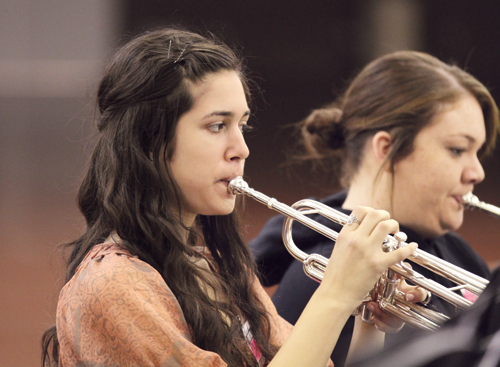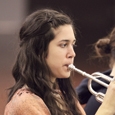
With the myriad cornet and trumpet parts called for in concert band repertoire, it is often difficult to seat the section in an efficient manner that lends itself to proper blend, balance and communication within the section. Many times, a system in which parts are simply passed down the line is adopted. Although this will work if there are three or four parts for similar instruments, the problems arise when a piece has parts for both cornets and trumpets. When starting rehearsal with such pieces, time is usually wasted finding out where the parts are located and where to seat the players. This usually results in awkward seat changes or worse, having students perform their parts without regard to who is seated where.
Some conductors move the trumpet parts to the end of the section, isolating the first trumpet and cornet parts from each other and possibly causing dynamic, blend, and intonation problems. While performing as the principal cornet of the United States Air Force Heritage of America Band, I was charged with assigning parts for the cornet/trumpet section and developed a system to alleviate the above problems. When seating a cornet/trumpet section, the amount of movement within the section from piece to piece should be limited. In addition, strong players should be split between cornet and trumpet parts, and the two firsts should be seated next to each other.
Small Sections
Where possible, a six-person section works well for smaller bands. This scenario is successful for most part divisions and allows for an assistant first cornet to help mitigate any range and endurance demands. A seating formula for this type of section can be seen above.

Large Sections
In larger sections, I would place two strong players to the left of the principal; these players are assigned the trumpet parts in a three-cornet-two-trumpet scenario and would be rolled into the first section of any work with homogeneous parts. After the first four players are positioned, simply go down the line in audition order to place the remaining musicians.

Exceptions
When using a rotating system, the players move, but the seat positions remain the same. This keeps the leadership positions in the same place and provides consistency to both the conductor and the section.
In many Alfred Reed pieces, the section is divided into three trumpets and two cornets. In this situation, I gave the Trumpet 1 part to the principal player and the two cornet parts to the players to the left of the principal. This doubles the prominent trumpet parts while allowing for single players to perform the lighter, more soloistic cornet parts.
If flugelhorn parts are needed in older march or overture scores, place them at the end of the cornet section.
Use of these charts should make this confusing task much easier for the librarians, section leaders, and directors who assign the parts. It will also promote a section where the roles and lines of communication between individual members as well with the conductor are defined clearly. l





